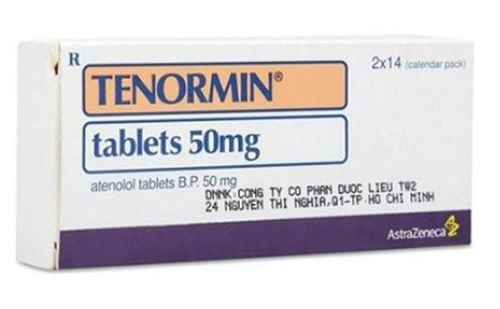This is an automatically translated article.
Atenstad has the main ingredient Atenolol, which belongs to the group of beta-adrenergic receptor blockers. Let's find out what Atenstad has to do with the effects, dosage and notes when using it in the article below.
1. What is Atenstad?
Atenstad has the main ingredient Atenolol, which belongs to the group of beta-adrenergic receptor blockers. Thanks to the mechanism of reducing sympathetic tone, Atenolol has the effect of reducing heart rate, cardiac contractility, atrioventricular conduction rate and reducing plasma renin activity.
2. Indications of the drug Atenstad
Atenstad is indicated in the treatment of hypertension, arrhythmia, angina pectoris, early intervention in the acute phase of myocardial infarction.
3. Dosage of Atenstad
Hypertension: The recommended starting dose is 25-50mg once a day. The antihypertensive effect is achieved after 1-2 weeks. The dose may be increased up to 100 mg once daily for optimal response.
Chronic stable angina: The starting dose is 50mg x 1 time/day. If an optimal response is not achieved within 1 week, the dose may be increased to 100 mg once daily.
Arrhythmias: Maintenance dose is 50-100mg/day, given as a single dose (after control with intravenous atenolol).
Early treatment of acute myocardial infarction: If the patient can tolerate a dose of 10mg intravenously, 50mg can be given orally 10 minutes after injection, 12 hours later, another 50mg orally.
Patients with renal impairment: Consider dose reduction in patients with renal impairment, based on creatinine clearance:
Clearance 15-35ml/min every 1.73m2: The maximum recommended dose is 50mg/day. Clearance less than 15ml/min every 1.73m2: 25mg/day or 50mg every other day. How to use:
Atenstad is taken orally before meals.
4. Contraindications of Atenstad
Atenstad is contraindicated in the following subjects:
Sinus bradycardia, cardiogenic shock, first degree upper atrioventricular block, obvious heart failure or decompensated heart failure. Hypersensitivity to any of the ingredients of the drug. Used in combination with Verapamil.
5. Undesirable effects of the drug Atenstad
Some unwanted effects of Atenstad may be experienced such as dizziness, fatigue, sweating, drowsiness, mild headache and cold extremities.
The drug may aggravate peripheral obstructive disease, causing conjunctivitis, decreased lacrimation, hypoglycemia in diabetics, muscle spasticity, muscle weakness and impotence.
6. Be careful when using Atenstad
Before stopping treatment with Atenolol, the dose should be reduced gradually over 2 weeks.
Caution when using Atenstad drug on the following subjects:
Have asthma or a history of obstructive airway disease. Diabetes with unstable high blood glucose levels. The patient is on a strict diet for a long time. The patient has strenuous activity. Have a pheochromocytoma (a tumor of the adrenal medulla and have been previously treated with an alpha blocker). Reduced kidney function. Atenstad should only be used if clearly needed in patients with a history of severe hypersensitivity reactions and in patients receiving specific desensitization therapy, with a history or family history of psoriasis.
Taking Atenolol can give a positive doping test.
The drug should not be used in patients with rare hereditary galactose intolerance, the Lapp lactase deficiency or glucose-galactose malabsorption.
Use Atenstad during pregnancy only if absolutely necessary, carefully weighing the benefits and risks. Monitor with caution when administering Atenstad to a nursing woman.
The basic information about Atenstad in the above article is for reference only. Because Atenstad is a prescription drug, patients should not use it on their own, but need to contact a specialist directly for a suitable prescription to ensure safety for health.













